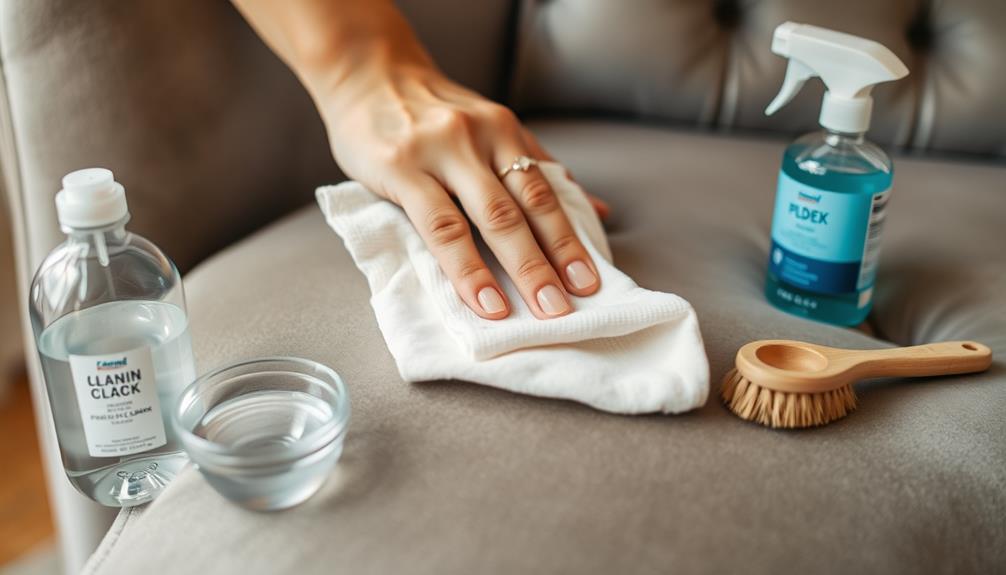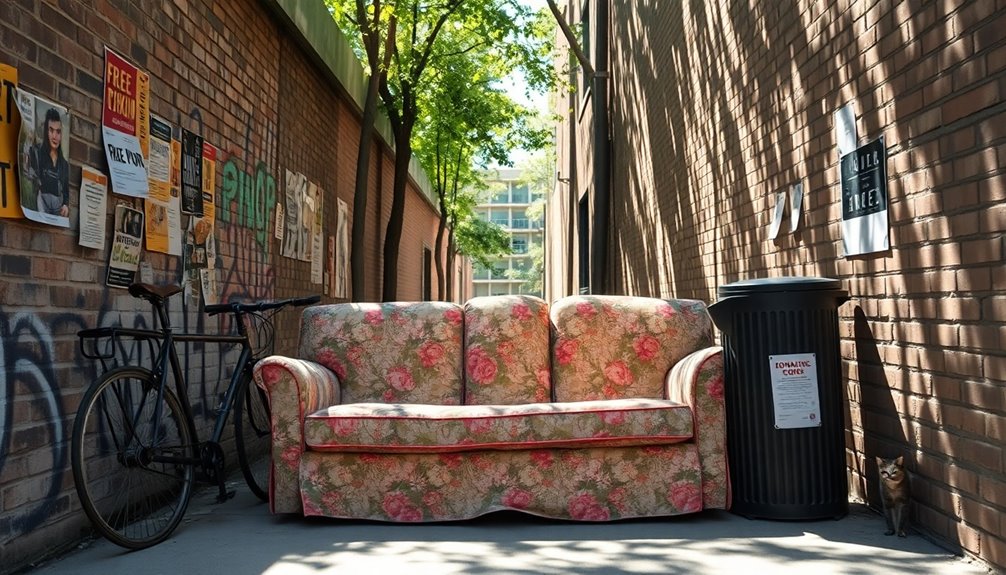In order to keep your velvet sofa clean, make sure to vacuum it weekly using a gentle brush attachment to remove dust and allergens. If there are any spills, immediately blot the area with a clean, absorbent cloth to prevent stains. For tougher marks, you can use a mild solution of dish soap and water sparingly. Avoid rubbing and instead, gently work with a soft brush following the direction of the pile to maintain texture. For a more thorough cleaning, consider professional services or steam cleaning. Regular maintenance will not only keep your sofa looking fresh but also extend its lifespan. There’s more to learn about optimal care! When it comes to caring for your velvet sofa, remember to follow specific cleaning instructions provided by the manufacturer and use a velvet-specific upholstery cleaner for deep cleaning at regular intervals. Additionally, rotating the cushions frequently can help prevent uneven wear. By following these suggestions, you can ensure that your velvet sofa remains luxurious and comfortable for many years to come. And for tough stains, consider using a stain remover specifically formulated for velvet upholstery. Test the product in an inconspicuous spot before applying it to the stained area. Other tips for removing sofa stains include addressing them promptly, using a clean cloth or sponge, and avoiding harsh chemicals that can damage the delicate fabric. By incorporating these tips into your cleaning routine, you can effectively preserve the beauty and comfort of your velvet sofa long-term.
Key Takeaways
- Regularly vacuum your velvet sofa with a soft brush attachment to prevent dirt buildup and maintain its plush texture.
- Blot spills immediately with a microfiber cloth to absorb liquid and minimize staining; avoid rubbing the fabric.
- For tough stains, use a gentle cleaning solution of equal parts distilled water and white vinegar, applying it with a damp cloth.
- Steam clean occasionally to lift fibers and remove trapped dust; always move the steamer in a grid pattern for even coverage.
- Schedule professional cleaning every 1-2 years, especially for natural fiber velvets, to maintain appearance and extend the sofa's lifespan.
Understanding Velvet Fabric

Velvet is a luxurious fabric that stands out for its soft, plush texture, created through a unique weaving process. This involves weaving two layers of fabric and cutting the pile to achieve that signature softness.
You'll find various types of velvet fabric available today, ranging from cotton to synthetic options. Synthetic velvet, in particular, is popular due to its durability and stain resistance, making it a smart choice for homes with kids and pets. For those considering pet-friendly options, understanding how to properly maintain fabrics is crucial, guaranteeing longevity even in lively environments proper care techniques.
When choosing velvet, consider the fiber content, as it can greatly affect how you care for it. While natural fiber velvets often require more delicate cleaning methods, synthetic velvet is generally easier to maintain.
Just keep in mind that regardless of the type, velvet is sensitive to fading, especially when exposed to direct sunlight. To preserve its vibrant colors, position your velvet furniture away from bright light.
Understanding the different types of velvet will help you select the right one for your needs and guarantee you use the proper cleaning methods to keep it looking its best.
Cleaning Frequency Recommendations

To keep your velvet sofa looking pristine, establishing a cleaning routine is essential. Aim for a cleaning frequency of at least once a week. This should include dusting and vacuuming to prevent dirt and allergens from building up.
Incorporating professional cleaning services can also enhance the longevity of your sofa, especially after heavy use or exposure to spills, as seen in mechanic shops for fuel injection services. If you have pets or children, you might need to increase your maintenance efforts to keep your sofa fresh and clean.
In addition to regular upkeep, you should perform a deep cleaning every 6 to 12 months. The exact timing depends on how much you use your sofa and how often it's exposed to spills or stains.
Remember, addressing spills immediately is vital. The sooner you act, the less likely you're to face permanent damage to the fabric.
Regular maintenance not only enhances the appearance of your velvet sofa but also extends its lifespan. By following these cleaning frequency recommendations, you can guarantee your sofa remains a beautiful and inviting centerpiece in your living space.
Essential Cleaning Tools

Having the right tools makes all the difference when cleaning your velvet sofa. Start with a vacuum cleaner that features a soft brush attachment. This will help you efficiently remove dust and debris without damaging those delicate velvet fibers. Regular vacuuming keeps your sofa looking fresh and prevents dirt buildup.
Additionally, consider keeping your cleaning supplies in a designated area to guarantee you have everything on hand when needed, similar to how proper piercing care and hygiene is essential for maintaining body piercings.
When accidents happen, a microfiber cloth is your best friend. Its absorbent properties allow you to blot spills and stains effectively, while its non-abrasive texture guarantees you won't harm the fabric. For those stubborn stains, consider a gentle cleaning solution made from distilled white vinegar mixed with water. This natural solution can tackle tough spots without compromising the integrity of your sofa.
To restore your velvet's luxurious texture, keep a soft-bristle brush handy. After cleaning, gently brush the fabric to lift any flattened fibers and maintain that plush look.
General Cleaning Techniques

When it comes to keeping your velvet sofa in top shape, regular maintenance is key. Here are some general cleaning techniques to guarantee your sofa remains looking its best:
1. Vacuum Regularly: Use a soft brush attachment to gently vacuum your velvet sofa, removing dust, crumbs, and pet hair. This prevents buildup and maintains its luxurious appearance.
For ideal dust removal, consider the best vacuums for dust removal in 2024 that are specifically designed for effective cleaning.
2. Brush the Fabric: After vacuuming, gently brush the surface of the velvet in the direction of the pile with a soft-bristle brush. This helps restore the fabric's texture and keeps it looking fresh.
3. Spot Clean Spills: If you spill something, act quickly by blotting the area with an absorbent cloth or paper towel.
For dried stains, use a mild soap and water solution to help lift the mark without damaging the fabric.
4. Schedule Professional Cleaning: Aim for a professional cleaning every 1-2 years, especially for natural fiber velvets.
This thorough care guarantees your sofa remains in ideal condition.
Spot Cleaning Methods

Occasionally, accidents happen, and knowing how to spot clean your velvet sofa can save it from lasting damage. For fresh stains, act quickly by blotting the area with a soft, lint-free cloth. This helps soak up excess liquid without rubbing, which can damage the delicate fabric fibers.
If the stain is less fresh, create a gentle cleaning solution using a mixture of dish soap and water. Applying only the suds with a damp cloth to avoid saturating the velvet is essential. Additionally, using essential oils like eucalyptus oil can provide a revitalizing scent in your cleaning routine while helping to maintain a pleasant atmosphere in your home. For particularly stubborn odors, consider adding a few drops of vinegar to your cleaning solution, as it can help neutralize smells. After cleaning, proper ventilation is vital to ensure that the velvet dries thoroughly and to help remove musty smell from furniture. You may also want to place an open container of baking soda nearby to further absorb any lingering odors and keep your space feeling fresh.
For oily stains, sprinkle cornstarch or talcum powder over the area and let it sit for 8-24 hours. This allows it to absorb the oil effectively before you vacuum it away.
When dealing with pet hair or lint, try using rubber gloves lightly sprayed with hairspray. Wipe them over the fabric, and watch as they collect hair effortlessly.
Before using any cleaning product, always test it on a hidden area of the sofa first. This guarantees that it won't cause discoloration or damage to the beautiful velvet.
Steam Cleaning Tips

After addressing spot cleaning, it's time to contemplate steam cleaning as another effective method for maintaining your velvet sofa. This technique not only freshens up your upholstery but also helps restore the pile.
Regular maintenance of your furniture, much like the air purifier maintenance dos and don'ts, guarantees longevity and enhances appearance.
Follow these steam cleaning tips for the best results:
- Use a Handheld Steamer: Set it to low heat and maintain a distance of several inches from the fabric to prevent damage.
- Employ a Grid Pattern: Move the steamer in a grid pattern to guarantee even distribution of steam and avoid over-saturating any single area, which could create water stains.
- Blot the Damp Areas: After steaming, gently blot any damp spots with a dry microfiber towel. Rotate it frequently to keep dirt from transferring back onto the fabric.
- Brush the Fabric: After steaming, use a velvet upholstery brush to gently brush the fabric in the opposite direction of the nap. This will help maintain the texture and enhance the appearance.
Regular steam cleaning not only lifts and revitalizes the fibers but also removes trapped dust and allergens, keeping your velvet sofa looking fresh and inviting.
Stain Removal Strategies

Dealing with stains on your velvet sofa can be a challenging task, but knowing the right strategies makes it manageable.
Start by addressing fresh stains immediately; gently blot the stain with a soft, absorbent cloth to prevent it from setting. Avoid rubbing, as this can damage the delicate fibers.
For oily stains, sprinkle a thick layer of cornstarch or talcum powder over the area and let it sit for 8-24 hours to absorb the oil before vacuuming it away. Additionally, consider using natural remedies alongside conventional cleaning methods, as they can often provide effective solutions without harsh chemicals. For further guidance, refer to natural remedies.
If you encounter a stubborn stain, use a cleaning solution made from equal parts distilled water and white vinegar. Dampen a microfiber cloth with this solution and gently blot the stained area, ensuring you don't saturate the velvet.
For tougher stains, create a paste using lemon juice and bicarbonate of soda, apply it to the stain, allow it to dry, and then gently brush away the residue.
Before trying any cleaning product or solution, always test it on a hidden area of the fabric first.
If the stains persist despite your efforts, consider professional cleaning to restore your sofa's beauty.
Maintenance for Longevity

To keep your velvet sofa looking its best for years, regular maintenance is essential. By following these simple steps, you can guarantee its longevity and vibrant appearance.
Additionally, maintaining a unique aroma in your home can enhance the overall ambiance, similar to how burning coffee beans creates a welcoming environment.
- Vacuum Weekly: Use a soft brush attachment to vacuum your sofa at least once a week. This removes dust and prevents dirt buildup, maintaining its appearance.
- Fluff and Rotate Cushions: Periodically fluff and rotate your cushions. This helps guarantee even wear and prevents flattening of the fabric, extending the life of your sofa.
- Limit Sun Exposure: Protect your sofa from direct sunlight. Place it away from windows or use drapes to prevent fading over time.
- Blot Spills Immediately: Address any spills or stains as soon as they happen. Blot with an absorbent cloth instead of rubbing, as this can damage the fibers and alter the texture of the velvet.
When to Seek Professional Help

If your velvet sofa has noticeable damage like tears or fraying, it's time to call in a professional for repairs.
Additionally, if you've been ignoring the importance of maintaining your furniture, consider that a well-kept sofa can enhance your home's overall financial value, much like investment strategies that improve your portfolio.
Similarly, if you're struggling with stubborn stains that just won't budge, expert cleaners can tackle those with specialized treatments.
Addressing these issues early can save you from further damage and keep your sofa looking its best.
Significant Damage Repair
When faced with significant damage to your velvet sofa, how can you determine if it's time to call in a professional? Here are some clear signs to look for:
1. Tears or Rips: If you see noticeable tears or rips in the fabric, these issues require specialized repair techniques that only professionals can provide.
Additionally, similar to how the presence of security systems can deter potential threats, addressing fabric damage early can prevent further deterioration.
2. Fraying Edges: Fraying fabric can worsen if not addressed quickly.
Professional help guarantees a proper fix, restoring the sofa's integrity.
3. Stubborn Stains: If your cleaning efforts fail against deep-set stains, it's time to consult experts who've access to advanced stain removal products.
Much like how the effectiveness of home security systems can prevent further issues, timely interventions can save your sofa from lasting damage.
4. Persistent Odors or Allergens: Trapped allergens or odors that regular cleaning can't remove may necessitate professional cleaning services for a thorough treatment.
Always check the care tag on your velvet sofa for specific cleaning instructions.
Many manufacturers recommend professional cleaning to maintain warranties, especially for delicate or high-end materials.
Deep Stain Treatment
Significant damage can often signal the need for professional help, especially when it comes to deep stains on your velvet sofa. If you find that stains are deeply set or persist despite your best home treatment efforts, it's time to call in the experts.
Professional cleaning services have specialized equipment and solutions designed to effectively target and lift those stubborn stains that regular methods might miss.
When dealing with high-end or delicate velvet fabric, like pure silk, the stakes are even higher. DIY cleaning methods can risk further damage, so professional intervention is essential.
Additionally, if your sofa harbors odors or allergens that regular cleaning hasn't resolved, a professional deep stain treatment can make a significant difference.
Also, if your velvet sofa shows signs of significant damage, such as rips or fraying, professional help is necessary not only for stain removal but also for proper repair and restoration.
Don't hesitate to reach out for professional cleaning when the situation calls for it; it's a worthwhile investment in maintaining the beauty and longevity of your cherished velvet sofa.
Frequently Asked Questions
What Do I Use to Clean a Velvet Couch?
To clean a velvet couch, use a vacuum with a soft brush attachment weekly. For stains, mix equal parts vinegar and water, blot gently, and always test any cleaner on a hidden area first.
Will Water Ruin a Velvet Couch?
Yes, water can ruin a velvet couch. It causes stains and changes the texture if not blotted immediately. Always use a damp cloth for cleaning, and avoid soaking to prevent lasting damage.
How Do You Clean Dirty Velvet Fabric?
Imagine a delicate flower, needing gentle care. To clean dirty velvet fabric, you'll vacuum softly, blot stains gently, and use a vinegar solution. Let it breathe and brush the fibers to restore their beauty.
Is Velvet Sofa Washable?
You can't wash velvet sofas in a machine. Instead, check the care label for specific instructions. For cleaning, spot treatment or professional services are best to preserve the fabric's appearance and avoid water damage.
Conclusion
So, there you have it! With a bit of elbow grease and the right tools, your velvet sofa can look as good as new. Just remember, it's not just a couch; it's a throne of comfort that deserves royal treatment. After all, who wouldn't want to sit on a piece of furniture that's more high-maintenance than a cat? Treat your velvet with care, and it'll reward you with elegance—until the next spill, of course!









